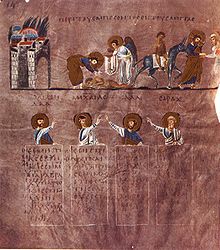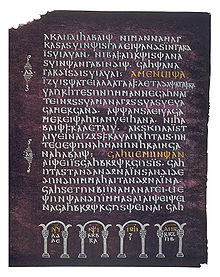Our website is made possible by displaying online advertisements to our visitors.
Please consider supporting us by disabling your ad blocker.
Purple parchment


Purple parchment or purple vellum refers to parchment dyed purple; codex purpureus refers to manuscripts written entirely or mostly on such parchment. The lettering may be in gold or silver. Later[when?] the practice was revived for some especially grand illuminated manuscripts produced for the emperors in Carolingian art and Ottonian art, in Anglo-Saxon England and elsewhere. Some just use purple parchment for sections of the work; the 8th-century Anglo-Saxon Stockholm Codex Aureus alternates dyed and un-dyed pages.
It was at one point supposedly restricted for the use of Roman or Byzantine emperors, although in a letter of Saint Jerome of 384, he "writes scornfully of the wealthy Christian women whose books are written in gold on purple vellum, and clothed with gems".[1]
- ^ Needham, 21
Previous Page Next Page


